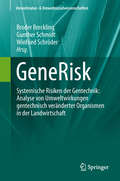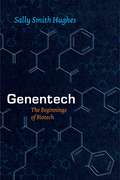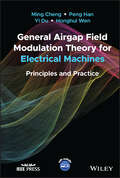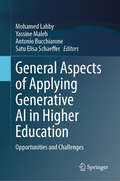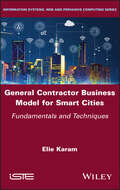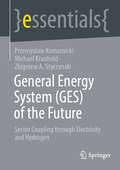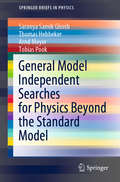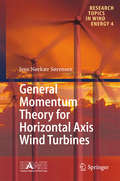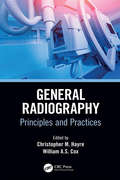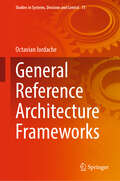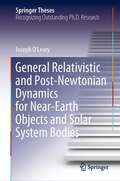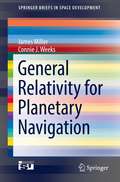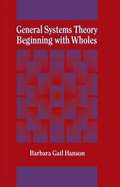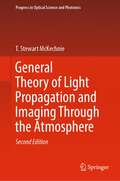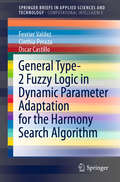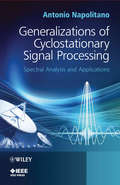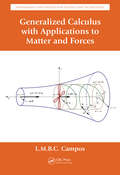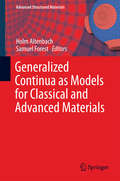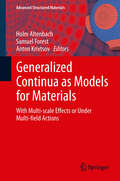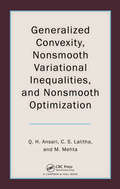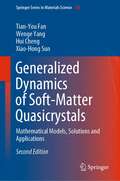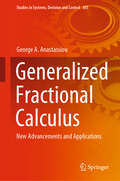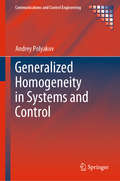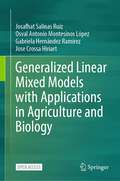- Table View
- List View
GeneRisk
by Broder Breckling Winfried Schröder Gunther SchmidtDas Buch gibt einen Einblick in systemische Verknüpfungen, denen der Anbau von gentechnisch veränderten Pflanzen in Deutschland unterliegen würde. Es thematisiert Verknüpfungen, die sich zwischen ökologischen und sozialen Systemzusammenhängen herstellen lassen. Bisherige Betrachtungen widmeten sich dem Thema entweder aus ökologischer Perspektive oder thematisieren (agrar-)politische Zusammenhänge. Das Buch resultiert aus einem Forschungsprojekt, in welchem das BMBF die Erforschung sozialökologischer Wechselwirkungen gefördert hat.
Genentech: The Beginnings of Biotech
by Sally Smith HughesIn the fall of 1980, Genentech, Inc. , a little-known California genetic engineering company, became the overnight darling of Wall Street, raising over $38 million in its initial public stock offering. Lacking marketed products or substantial profit, the firm nonetheless saw its share price escalate from $35 to $89 in the first few minutes of trading, at that point the largest gain in stock market history. Coming at a time of economic recession and declining technological competitiveness in the United States, the event provoked banner headlines and ignited a period of speculative frenzy over biotechnology as a revolutionary means for creating new and better kinds of pharmaceuticals, untold profit, and a possible solution to national economic malaise. Drawing from an unparalleled collection of interviews with early biotech players, Sally Smith Hughes offers the first book-length history of this pioneering company, depicting Genentech's improbable creation, precarious youth, and ascent to immense prosperity. Hughes provides intimate portraits of the people significant to Genentech's science and business, including cofounders Herbert Boyer and Robert Swanson, and in doing so sheds new light on how personality affects the growth of science. By placing Genentech's founders, followers, opponents, victims, and beneficiaries in context, Hughes also demonstrates how science interacts with commercial and legal interests and university research, and with government regulation, venture capital, and commercial profits. Integrating the scientific, the corporate, the contextual, and the personal, Genentech tells the story of biotechnology as it is not often told, as a risky and improbable entrepreneurial venture that had to overcome a number of powerful forces working against it.
General Airgap Field Modulation Theory for Electrical Machines: Principles and Practice
by Yi Du Ming Cheng Peng Han Honghui WenGeneral Airgap Field Modulation Theory for Electrical Machines Introducing a new theory for electrical machines Air-gap magnetic field modulation phenomena have been widely observed in electrical machines. This book serves as the first English-language overview of these phenomena, as well as developing systematically for the first time a general theory by which to understand and research them. This theory not only serves to unify analysis of disparate electrical machines, from conventional DC machines, induction machines, and synchronous machines to unconventional flux-switching permanent magnet machines, Vernier machines, doubly-fed brushless machines etc., but also paves the way towards the creation of new electrical machine topologies. General Airgap Field Modulation Theory for Electrical Machines includes both overviews of key concepts in electrical machine engineering and in-depth specialized analysis of the novel theory itself. It works through the applications of the developed theory before proceeding to both qualitative analysis of the theory’s operating principles and quantitative analysis of its parameters. Readers will also find: The collective experience of four award-winning authors with long records of international scholarship on this subject Three separate chapters covering the principal applications of the theory, with detailed examples Discussion of potential innovations made possible by this theory General Airgap Field Modulation Theory for Electrical Machines is an essential introduction to this theory for postgraduates, researchers, and electrical engineers.
General Aspects of Applying Generative AI in Higher Education: Opportunities and Challenges
by Antonio Bucchiarone Yassine Maleh Mohamed Lahby Satu Elisa SchaefferThis book explores the transformative impact of generative artificial intelligence (GenAI) on teaching and learning, examining how recent advancements in GenAI are revolutionizing educational practices across disciplines. The book is organized into three parts: an overview of GenAI in education, its application in diverse educational contexts, and future perspectives on how educators and GenAI can interface. The first part addresses the pressing concerns within the educational landscape, both the bridges GenAI allows us to build and the remaining as well as the emerging gaps. The middle part explores specific academic disciplines, such as history, sports medicine, mathematics, engineering, and the humanities, dissecting the influence of GenAI on each. The final part looks ahead, discussing the ethical implications, the evolving role of prompting, and innovative frameworks for personalized learning. By presenting a balanced view of the opportunities that are now within reach through GenAI and the challenges such leaps pose to the way we learn and teach, this book allows interested educators to learn from the early-adopting contributors to fruitfully and responsibly integrate such technologies into their pedagogical practices. It serves as a resource for anyone interested in the future of educational practices and research of education, offering insights that can spark further exploration and discussion within the academic community and educational policy makers.
General Contractor Business Model for Smart Cities: Fundamentals and Techniques
by Elie KaramThis book covers three principal subject areas: smart cities, general contractors and business models. The smart city concept is currently on the rise and cities around the world appear to be in a race to become smart, fast. Converting big cities into smart cities is a move that almost all cities around the globe have made, or will undoubtedly make in the near future, to be able to cope with the various repercussions of urbanization. Smartness is a vague term that could relate to anything and everything, such as infrastructure, people or governance.In this book, we focus our attention on smart buildings - large ones, in particular - and attempt to identify the key problems that France-based construction companies face today, in order to suggest plausible solutions. Our research findings show that no single business model can fit all smart cities worldwide. Using the general contractor business model for smart cities, this book proposes an original solution to managing smart city projects, bringing together architecture, construction and strategy.
General Energy System: Sector Coupling through Electricity and Hydrogen (essentials)
by Zbigniew A. Styczynski Przemyslaw Komarnicki Michael KranholdThis essential provides a compact overview of the genesis and the implementation steps taken so far in the energy transition and describes in particular the framework conditions of the changing energy system. Thus, the book is excellently suited as an introductory read into the subject of the energy transition, which will also lead to the creation of a holistic total energy system.
General Model Independent Searches for Physics Beyond the Standard Model (SpringerBriefs in Physics)
by Arnd Meyer Saranya Samik Ghosh Thomas Hebbeker Tobias PookThis primer describes the general model independent searches for new physics phenomena beyond the Standard Model of particle physics. First, the motivation for performing general model independent experimental searches for new physics is presented by giving an overview of the current theoretical understanding of particle physics in terms of the Standard Model of particle physics and its shortcomings. Then, the concept and features of general model independent search for new physics at collider based experiments is explained. This is followed by an overview of such searches performed in past high energy physics experiments and the current status of such searches, particularly in the context of the experiments at the LHC. Finally, the future prospects of such general model independent searches, with possible improvements using new tools such as machine learning techniques, is discussed.
General Momentum Theory for Horizontal Axis Wind Turbines
by Jens Nørkær SørensenThis book reconsiders the basic approaches behind the BEM method and in particular assesses and validates the equations forming the general momentum theory. One part of the book concerns the validation, using numerical fluid mechanics (CFD), of the different terms in the equations forming the momentum theory. Other parts present new ideas for extending the theory and for enhancing the accuracy of the BEM approach. Besides a general introduction and explanation of the momentum theory, the book also deals with specialized topics, such as diffusor-augmented rotors, wind tunnel corrections, tip corrections, and combined momentum/vortex theory for design of wind turbine rotors. The book contains new as well as already published material, and the author has strived to put the material into a new and more consistent context than what usually is found in similar text books. The book is primarily intended for researchers and experienced students with a basic knowledge in fluid mechanics wishing to understand and expand their knowledge on wind turbine aerodynamics. The book is self-consistent, hence all necessary derivations are shown, and it should not be necessary to seek help in other literature to understand the contents of the book.
General Radiography: Principles and Practices (Medical Imaging in Practice)
by Christopher M. HayreWith chapters from globally recognized academics, General Radiography shows the multifaceted approach to general radiography and how it enhances healthcare delivery. Potentially influential to how healthcare delivery is offered, it begins with the pertinent chapters examining image acquisition and dose optimization in diagnostic radiography. Next, chapters reflect and critically discuss aspects central to patient care, and imaging within trauma, critical care and pediatric situations. The final section of this book then explores the learning, teaching and education in the field of diagnostic radiography, with novel strategies illustrated.
General Reference Architecture Frameworks (Studies in Systems, Decision and Control #73)
by Octavian IordacheStudying high complexity projects implementation is the object of this book. Multiple interactions and emergences are the core of higher complexity and of associated models and projects. The starting point of our approach is the observed similarity or isomorphism of roadmaps toward higher complexity and of reference architectures for different domains of reality. The objective is to propose a General Polytopic Roadmaps (GPTR) and a General Reference Architecture Framework (GRAF) and use these for 8D Program implementation. The GPTR shows the stages: 0D, 1D, 2D, 4D, and 8D. The book is divided into 8 chapters. Chapter 1 introduces the GRAF as a 4D of 4D polytope. Chapter 2 emphasizes the role for the dialogue of processes in duality, of the logic of contradiction, of iteration and of included middle to face high complexity. Chapter 3 refers to operations and equipments of engineering interest as permutations, mixings and separations. Chapter 4 refers to modeling and simulation. Chapter 5 concerns creative design models. Dual process design, and processes integration are presented. Industry 4.0, future developments to Industry 8.0 and chemical engineering paradigms are evaluated in Chapter 6. Chapter 7 focuses on complex systems as production systems of systems architecture frameworks, decision models, operations processes, and cyber-physical social systems. Chapter 8 discusses implementation of high complexity projects for different levels of reality. The book is useful to engineers, researchers, entrepreneurs, and students in different branches of production, science, and engineering of high complexity.
General Relativistic and Post-Newtonian Dynamics for Near-Earth Objects and Solar System Bodies (Springer Theses)
by Joseph O’LearyOwing to the increased accuracy requirements in fields such as astrometry and geodesy the general theory of relativity must be taken into account for any mission requiring highly accurate orbit information and for practically all observation and measurement techniques. This book highlights the confluence of Applied Mathematics, Physics and Space Science as seen from Einstein's general theory of relativity and aims to bridge the gap between theoretical and applied domains. The book investigates three distinct areas of general relativity: Exact solutions of the Einstein field equations of gravitation. Dynamics of near-Earth objects and solar system bodies. Relativistic orbitography. This book is an updated and expanded version of the author’s PhD thesis which was awarded the International Astronomical Union PhD prize in Division A: Fundamental Astronomy. Included is a new introduction aimed at graduate students of General Relativity and extended discussions and results on topics in post-Newtonian dynamics and general relativistic spacecraft propagation.
General Relativity for Planetary Navigation (SpringerBriefs in Space Development)
by James Miller Connie J. WeeksThis brief approaches General Relativity from a planetary navigation perspective, delving into the unconventional mathematical methods required to produce computer software for space missions. It provides a derivation of the Einstein field equations and describes experiments performed on the Near Earth Asteroid Rendezvous mission, spanning General Relativity Theory from the fundamental assumptions to experimental verification.The software used for planetary missions is derived from mathematics that use matrix notation. An alternative is to use Einstein summation notation, which enables the mathematics to be presented in a compact form but makes the geometry difficult to understand. In this book, the relationship of matrix notation to summation notation is shown. The purpose is to enable the reader to derive the mathematics used in the software in either matrix notation or summation notation. This brief is a useful tool for advanced students and young professionals embarking on careers in planetary navigation.
General Systems Theory Beginning with Wholes
by Barbara Gail HansonThis book presents the central ideas of general systems theory in clear and simple language, with a focus on the social sciences.
General Theory of Light Propagation and Imaging Through the Atmosphere (Progress in Optical Science and Photonics #20)
by T. Stewart McKechnieThis 2nd edition lays out an updated version of the general theory of light propagation and imaging through Earth’s turbulent atmosphere initially developed in the late ‘70s and ‘80s, with additional applications in the areas of laser communications and high-energy laser beam propagation. New material includes a chapter providing a comprehensive mathematical tool set for precisely characterizing image formation with the anticipated Extremely Large Telescopes (ELTS), enabling a staggering range of star image shapes and sizes; existing chapters rewritten or modified so as to supplement the mathematics with clearer physical insight through written and graphical means; a history of the development of present-day understanding of light propagation and imaging through the atmosphere as represented by the general theory described. Beginning with the rudimentary, geometrical-optics based understanding of a century ago, it describes advances made in the 1960s, including the development of the ‘Kolmogorov theory,’ the deficiencies of which undermined its credibility, but not before it had done enormous damage, such as construction of a generation of underperforming ‘light bucket’ telescopes. The general theory requires no a priori turbulence assumptions. Instead, it provides means for calculating the turbulence properties directly from readily-measurable properties of star images.
General Thermodynamics
by Donald OlanderBecause classical thermodynamics evolved into many branches of science and engineering, most undergraduate courses on the subject are taught from the perspective of each area of specialization. General Thermodynamics combines elements from mechanical and chemical engineering, chemistry (including electrochemistry), materials science, and biology to present a unique and thorough treatment of thermodynamics that is broader in scope than other fundamental texts.This book contains classroom-tested materials designed to meet the academic requirements for students from a variety of scientific and engineering backgrounds in a single course. The first half focuses on classical concepts of thermodynamics, whereas the latter half explores field-specific applications, including a unique chapter on biothermodynamics. The book’s methodology is unified, concise, and multidisciplinary, allowing students to understand how the principles of thermodynamics apply to all technical fields that touch upon this most fundamental of scientific theories. It also offers a rigorous approach to the quantitative aspects of thermodynamics, accompanied by clear explanations to help students transition smoothly from the physical concepts to their mathematical representations. Each chapter contains numerous worked examples taken from different engineering applications, illustrations, and an extensive set of exercises to support the material. A complete solutions manual is available to professors with qualifying course adoptions.
General Type-2 Fuzzy Logic in Dynamic Parameter Adaptation for the Harmony Search Algorithm (SpringerBriefs in Applied Sciences and Technology)
by Oscar Castillo Fevrier Valdez Cinthia PerazaThis book focuses on the fields of fuzzy logic and metaheuristic algorithms, particularly the harmony search algorithm and fuzzy control. There are currently several types of metaheuristics used to solve a range of real-world of problems, and these metaheuristics contain parameters that are usually fixed throughout the iterations. However, a number of techniques are also available that dynamically adjust the parameters of an algorithm, such as probabilistic fuzzy logic.This book proposes a method of addressing the problem of parameter adaptation in the original harmony search algorithm using type-1, interval type-2 and generalized type-2 fuzzy logic. The authors applied this methodology to the resolution of problems of classical benchmark mathematical functions, CEC 2015, CEC2017 functions and to the optimization of various fuzzy logic control cases, and tested the method using six benchmark control problems – four of the Mamdani type: the problem of filling a water tank, the problem of controlling the temperature of a shower, the problem of controlling the trajectory of an autonomous mobile robot and the problem of controlling the speed of an engine; and two of the Sugeno type: the problem of controlling the balance of a bar and ball, and the problem of controlling control the balance of an inverted pendulum. When the interval type-2 fuzzy logic system is used to model the behavior of the systems, the results show better stabilization because the uncertainty analysis is better. As such, the authors conclude that the proposed method, based on fuzzy systems, fuzzy controllers and the harmony search optimization algorithm, improves the behavior of complex control plants.
Generalizations of Cyclostationary Signal Processing
by Antonio NapolitanoThe relative motion between the transmitter and the receiver modifies the nonstationarity properties of the transmitted signal. In particular, the almost-cyclostationarity property exhibited by almost all modulated signals adopted in communications, radar, sonar, and telemetry can be transformed into more general kinds of nonstationarity. A proper statistical characterization of the received signal allows for the design of signal processing algorithms for detection, estimation, and classification that significantly outperform algorithms based on classical descriptions of signals.Generalizations of Cyclostationary Signal Processing addresses these issues and includes the following key features: Presents the underlying theoretical framework, accompanied by details of their practical application, for the mathematical models of generalized almost-cyclostationary processes and spectrally correlated processes; two classes of signals finding growing importance in areas such as mobile communications, radar and sonar.Explains second- and higher-order characterization of nonstationary stochastic processes in time and frequency domains.Discusses continuous- and discrete-time estimators of statistical functions of generalized almost-cyclostationary processes and spectrally correlated processes.Provides analysis of mean-square consistency and asymptotic Normality of statistical function estimators.Offers extensive analysis of Doppler channels owing to the relative motion between transmitter and receiver and/or surrounding scatterers.Performs signal analysis using both the classical stochastic-process approach and the functional approach, where statistical functions are built starting from a single function of time.
Generalized Calculus with Applications to Matter and Forces (Mathematics and Physics for Science and Technology)
by Luis Manuel Braga de Costa CamposCombining mathematical theory, physical principles, and engineering problems, Generalized Calculus with Applications to Matter and Forces examines generalized functions, including the Heaviside unit jump and the Dirac unit impulse and its derivatives of all orders, in one and several dimensions. The text introduces the two main approaches to genera
Generalized Continua as Models for Classical and Advanced Materials
by Holm Altenbach Samuel ForestThis volume is devoted to an actual topic which is the focus world-wide of various research groups. It contains contributions describing the material behavior on different scales, new existence and uniqueness theorems, the formulation of constitutive equations for advanced materials. The main emphasis of the contributions is directed on the following items - Modelling and simulation of natural and artificial materials with significant microstructure, - Generalized continua as a result of multi-scale models, - Multi-field actions on materials resulting in generalized material models, - Theories including higher gradients, and - Comparison with discrete modelling approaches
Generalized Continua as Models for Materials
by Holm Altenbach Anton Krivtsov Samuel ForestThis volume presents contributions describing the micro- and macro-behaviours, new existence and uniqueness theorems, the formulation of multi-scale problems, etc. and now it is time to ponder again the state of matter and to discuss new trends and applications. The main focus is directed on the following items - Modelling and simulation of materials with significant microstructure, - Generalized continua as a result of multi-scale models, - Multi-field actions on materials resulting in generalized material models, and - Comparison with discrete modelling approaches
Generalized Convexity, Nonsmooth Variational Inequalities, and Nonsmooth Optimization
by Qamrul Hasan Ansari C. S. Lalitha Monika MehtaUntil now, no book addressed convexity, monotonicity, and variational inequalities together. Generalized Convexity, Nonsmooth Variational Inequalities, and Nonsmooth Optimization covers all three topics, including new variational inequality problems defined by a bifunction.The first part of the book focuses on generalized convexity and generalized
Generalized Dynamics of Soft-Matter Quasicrystals: Mathematical Models, Solutions and Applications (Springer Series in Materials Science #260)
by Tian-You Fan Wenge Yang Hui Cheng Xiao-Hong SunThis book highlights the mathematical models and solutions of the generalized dynamics of soft-matter quasicrystals (SMQ) and introduces possible applications of the theory and methods. Based on the theory of quasiperiodic symmetry and symmetry breaking, the book treats the dynamics of individual quasicrystal systems by reducing them to nonlinear partial differential equations and then provides methods for solving the initial-boundary value problems in these equations. The solutions obtained demonstrate the distribution, deformation and motion of SMQ and determine the stress, velocity and displacement fields. The interactions between phonons, phasons and fluid phonons are discussed in some fundamental materials samples. The reader benefits from a detailed comparison of the mathematical solutions for both solid and soft-matter quasicrystals, gaining a deeper understanding of the universal properties of SMQ. The second edition covers the latest research progress on quasicrystals in topics such as thermodynamic stability, three-dimensional problems and solutions, rupture theory, and the photonic band-gap and its applications. These novel chapters make the book an even more useful and comprehensive reference guide for researchers in condensed matter physics, chemistry and materials sciences.
Generalized Fractional Calculus: New Advancements and Applications (Studies in Systems, Decision and Control #305)
by George A. AnastassiouThis book applies generalized fractional differentiation techniques of Caputo, Canavati and Conformable types to a great variety of integral inequalities e.g. of Ostrowski and Opial types, etc. Some of these are extended to Banach space valued functions. These inequalities have also great impact in numerical analysis, stochastics and fractional differential equations. The book continues with generalized fractional approximations by positive sublinear operators which derive from the presented Korovkin type inequalities and also includes abstract cases. It presents also multivariate complex Korovkin quantitative approximation theory. It follows M-fractional integral inequalities of Ostrowski and Polya types. The results are weighted so they provide a great variety of cases and applications. The second part of the book deals with the quantitative fractional Korovkin type approximation of stochastic processes and lays there the foundations of stochastic fractional calculus. The book considers both Caputo and Conformable fractional directions and derives regular and trigonometric results. The positive linear operators can be expectation operator commutative or not. This book results are expected to find applications in many areas of pure and applied mathematics and stochastics. As such this monograph is suitable for researchers, graduate students, and seminars of the above disciplines, also to be in all science and engineering libraries.
Generalized Homogeneity in Systems and Control (Communications and Control Engineering)
by Andrey PolyakovThis monograph introduces the theory of generalized homogeneous systems governed by differential equations in both Euclidean (finite-dimensional) and Banach/Hilbert (infinite-dimensional) spaces. It develops methods of stability and robustness analysis, control design, state estimation and discretization of homogeneous control systems. Generalized Homogeneity in Systems and Control is structured in two parts. Part I discusses various models of control systems and related tools for their analysis, including Lyapunov functions. Part II deals with the analysis and design of homogeneous control systems. Some of the key features of the text include: mathematical models of dynamical systems in finite-dimensional and infinite-dimensional spaces; the theory of linear dilations in Banach spaces;homogeneous control and estimation;simple methods for an "upgrade" of existing linear control laws; numerical schemes for a consistent digital implementation of homogeneous algorithms; and experiments confirming an improvement of PID controllers. The advanced mathematical material will be of interest to researchers, mathematicians working in control theory and mathematically oriented control engineers.
Generalized Linear Mixed Models with Applications in Agriculture and Biology
by Osval Antonio Montesinos López Josafhat Salinas Ruíz Gabriela Hernández Ramírez Jose Crossa HiriartThis open access book offers an introduction to mixed generalized linear models with applications to the biological sciences, basically approached from an applications perspective, without neglecting the rigor of the theory. For this reason, the theory that supports each of the studied methods is addressed and later - through examples - its application is illustrated. In addition, some of the assumptions and shortcomings of linear statistical models in general are also discussed. An alternative to analyse non-normal distributed response variables is the use of generalized linear models (GLM) to describe the response data with an exponential family distribution that perfectly fits the real response. Extending this idea to models with random effects allows the use of Generalized Linear Mixed Models (GLMMs). The use of these complex models was not computationally feasible until the recent past, when computational advances and improvements to statistical analysis programs allowed users to easily, quickly, and accurately apply GLMM to data sets. GLMMs have attracted considerable attention in recent years. The word "Generalized" refers to non-normal distributions for the response variable and the word "Mixed" refers to random effects, in addition to the fixed effects typical of analysis of variance (or regression). With the development of modern statistical packages such as Statistical Analysis System (SAS), R, ASReml, among others, a wide variety of statistical analyzes are available to a wider audience. However, to be able to handle and master more sophisticated models requires proper training and great responsibility on the part of the practitioner to understand how these advanced tools work. GMLM is an analysis methodology used in agriculture and biology that can accommodate complex correlation structures and types of response variables.
